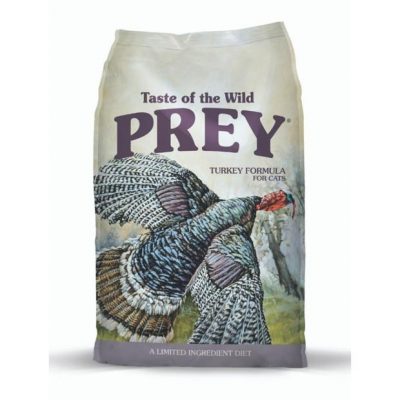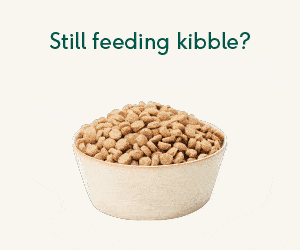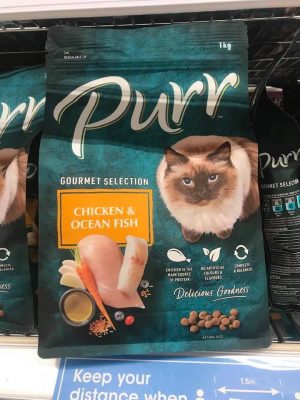
| Available from | Pet Circle, VeryPet |
Many cat foods contain a laundry list of ingredients as long as your arm, and in most cases you wonder what they’re all for, or if they’re even necessary. In many cases pet food manufacturers do this so the first ingredient is meat, yet the next five or six are something cheaper and less nutritious (for example: meat, filler, filler, filler, filler ~ which will then be marketed as “Meat is the FIRST ingredient!”).
In our Taste of the Wild PREY cat food review we’ll find out just how few ingredients are required to provide a “complete and balanced” food for a cat.
It’s also worth mentioning upfront that limited ingredient diets should always be one of the first steps to resolving signs of allergies or food sensitivities in a cat, such as itchy skin, itchy ears, scratching, eye gunk, sneezing, coarse coat, or fat cat syndrome*.
* Yes, I just made up fat cat syndrome, but it does happen to be rife in the cat world.
Onwards with our Taste of the Wild PREY review!
Taste of the Wild PREY cat food products
There are two formulas in the Taste of the Wild PREY cat food range. For this review we’ll focus on the Turkey formula, but you can consider both formulas equal.
Taste of the Wild PREY cat food review
What the marketing says
The marketing for Taste of the Wild PREY is refreshingly simple. It’s a limited ingredient yet complete and balanced cat food without any of the nasty fillers which cause health issues and sensitivities in cats. You may be surprised to know how many cat foods contain problematic ingredients such as wheat (cereals/cereal by-products), food colourings, artificial preservatives, soy, or corn. All of which are included in cat food to keep costs down, and none are good for your cat. It makes you wonder how they can call it “cat food”, when the simple fact is carnivores eat meat, not wheat.
What the ingredients really say
The first ingredient in Taste of the Wild PREY Turkey formula is, as we would expect, turkey. Given the protein of 33% we can deduce a significant amount of turkey in the food which is great news for our cats as a obligate carnivores. The fat percentage of 15% is also decent and ensures a low amount of carbs (we estimate 34% max).
The main source of carbs will be lentils as the second ingredient. Although not a meat ingredient these are a far better inclusion to the cereal grains you find in most cat foods, which are likely one of the most significant reasons so many cats get sick. Lentils are a far better inclusion, being a good source of nutrients (B vitamins, iron, zinc, and phosphorous), as well as being anti-allergenic, high in fibre, and low in starch.
Sunflower oil is listed third, so we’re already down to the less significant ingredients (it really is limited ingredient, isn’t it!). We also find salmon oil (source of DHA) as the 5th ingredient, so the two oils combined will offer your cat a source of energy and promote a healthy immune system.
We prefer not to see ambiguous ingredients in a cat food, so it’s a shame to see natural flavour as the 4th ingredient, but this will amount to some of the fat content of the food and will likely be some derivative of the turkey ingredient (i.e. the fat, broth, or digest).
There’s a decent list of vitamins and minerals and added probiotics for gut health. You’ll find on many cheaper cat foods vitamins and minerals included as “vitamins and minerals”, which usually amounts to a vitamin/mineral premix powder of dubious quality, so it’s nice to see these represented individually and accurately.
All in all, Taste of the Wild PREY cat food stacks up. It’s one of the highest rated and reviewed cat foods worldwide which should also provide some assurances. Recommended.
We hope our Taste of the Wild cat food review has offered some useful information and insight, and if your cat’s suffering any symptoms of food sensitivities then give this a try – if it works, let us know in the comments below!
Where to buy Taste of the Wild PREY cat food
Ingredients of Taste of the Wild PREY cat food
Ingredients of Taste of the Wild PREY dry cat food (Turkey formula) as of August 2021:
Turkey, lentils, sunflower oil (preserved with mixed tocopherols), natural flavor, salmon oil (source of DHA), DL-Methionine, dicalcium phosphate, calcium carbonate, salt, choline chloride, taurine, dried Lactobacillus plantarum fermentation product, dried Bacillus subtilis fermentation product, dried Lactobacillus acidophilus fermentation product, dried Enterococcus faecium fermentation product, dried Bifidobacterium animalis fermentation product, zinc proteinate, vitamin E supplement, niacin, manganese proteinate, copper proteinate, zinc sulfate, manganese sulfate, copper sulfate, thiamine mononitrate, vitamin A supplement, biotin, potassium iodide, calcium pantothenate, riboflavin, pyridoxine hydrochloride, vitamin B12 supplement, manganous oxide, sodium selenite, vitamin D3 supplement, folic acid.
Guaranteed analysis of Taste of the Wild PREY cat food
Guaranteed analysis of Taste of the Wild PREY dry cat food (Turkey formula) as of August 2021:
| Protein | (min) 33% |
| Fat | (min) 15% |
| Crude Fibre | (max) 3% |
| Carbohydrates * | (max) 34% (estimated) |
Taste of the Wild PREY cat food recalls
There are no known recalls of Taste of the Wild PREY cat food at the current time.








due to a shortage in sunflower oil worldwide, they have have changed the formula and replaced it with chicken fat, is this still considered single protein and hypoallergenic/good option for cats with allergies?
Hi Johanna, I consider chicken fat a much better alternative to sunflower oil for cats as carnivores. If your cat isn’t sensitive to chicken then I wouldn’t consider it problematic in that sense, and I find cats more sensitive to grains (which they shouldn’t be eating much of anyway).
Pet food suppliers need to learn what pets actually like to eat, always sloppy gravy, since when did cats eat cranberry
And silly additives, I have a fussy eater, bought heaps of food, sniffs and walks away, you should do samples of dry good quality dry, that’s what pet barn have been doing for me which is much appreciated,
Best regards
If you want samples ask the companies making the foods. Most don’t do samples, but there’s still a few that continue to do it. Simply email them asking if they do it and if they do provide your address to them.
If you don’t want them knowing your address than your going to have trouble getting samples.
A decent cat food would mimic the gut contents of prey with small amounts of fruits and vegetables, so it’s not a bad thing seeing something like cranberry in a cat food. I have more concerns when a cat food has non-meat ingredients making up the bulk of the formula, especially with excessive starch or cereal grains, which sadly sums up most commercial cat foods.